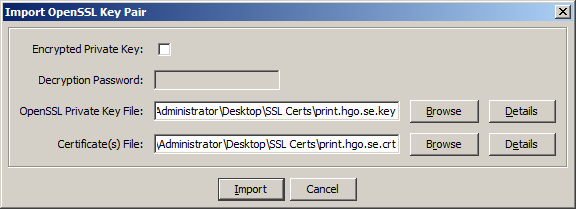
- OPENSSL PRINT CERTIFICATE INSTALL
- OPENSSL PRINT CERTIFICATE SOFTWARE
- OPENSSL PRINT CERTIFICATE PASSWORD
The next most common use case of OpenSSL is to create certificate signing requests for requesting a certificate from a certificate authority that is trusted. -noout - Needed not to output the encoded version of the certificate.-text - Strips the text headers from the output.-in - The certificate that we are verifying.x509 - This is a multipurpose command, and when combined with the other parameters here, it is for retrieving information about the passed in the certificate.The combination allows the certificate to be output in a format that is more easily readable by a person. The parameters here are for checking an x509 type certificate. openssl x509 -in certificate.crt -text -noout Once the certificate has been generated, we should verify that it is correct according to the parameters that we have set. -out - The location to output the certificate file itself.-keyout - The location to output the private key of the self-signed certificate.-newkey - The format of the key, in this case an RSA key with 4096 bit encryption.- days - The number of days that the certificate will be valid.
OPENSSL PRINT CERTIFICATE PASSWORD


Verify that the installation works by running the following command. The default options are the easiest to get started. Offering both executables and MSI installations, the recommended end-user version is the Light 圆4 MSI installation. One such source providing pre-compiled OpenSSL binaries is the following site by SLProWeb.
OPENSSL PRINT CERTIFICATE INSTALL
OpenSSL on Windows is a bit trickier as you need to install a pre-compiled binary to get started.

In the case of Ubuntu, simply running apt install OpenSSL will ensure that you have the binary available and at the newest version. OpenSSL is usually included in most Linux distributions.

OPENSSL PRINT CERTIFICATE SOFTWARE
OpenSSL can also be seen as a complicated piece of software with many options that are often compounded by the myriad of ways to configure and provision SSL certificates. OpenSSL has been one of the most widely used certificate management and generation pieces of software for much of modern computing.


 0 kommentar(er)
0 kommentar(er)
